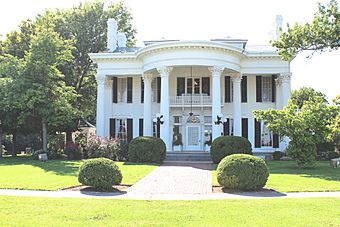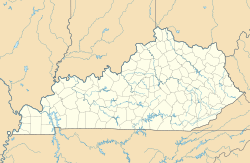Whitehaven (Paducah, Kentucky) facts for kids
Quick facts for kids |
|
|
Whitehaven
|
|

Whitehaven, 2016
|
|
| Location | Lone Oak Road, off I-24, Paducah, Kentucky |
|---|---|
| Built | 1865, 1907 |
| Architect | A. L. Lassiter |
| Architectural style | Classical revival |
| NRHP reference No. | 84001824 |
| Added to NRHP | 1984 |
Whitehaven is a special historic house in Paducah, Kentucky. It's also known as the Anderson-Smith House. Since 1983, it has been used as Kentucky's welcome center for people traveling on I-24. This is near the border with Illinois.
It's the only historic house in the United States that also works as a rest area. Whitehaven was added to the National Register of Historic Places on March 1, 1984. This means it's recognized as an important historical site.
Contents
Building Whitehaven: A Historic Home's Story
In 1865, a tobacco dealer named Edward L. Anderson built a simple brick farmhouse. The bricks for the house were made right on the property. This house stayed in the Anderson family for many years.
In 1903, a local businessman named Edward Lafayette Atkins bought the house. He wanted to make it much grander. Atkins asked his friend, architect Alda Lafayette Lassiter, to redesign the house. They decided to use the Classical Revival style. This style uses ideas from ancient Greek and Roman buildings.
Lassiter added a large, impressive staircase inside. He also put in fancy plaster ceilings with decorative trim called crown molding. Outside, he added a big porch called a portico. This portico had eight tall columns in the Corinthian style. The house was painted white, and Atkins named it Whitehaven.
New Owners and Changes: The Smith Family Era
In 1908, after his wife passed away, Edward Atkins sold Whitehaven. The new owner was James P. Smith, who was the mayor of Paducah. The Smith family made many changes to the house. They even hired a famous company, Marshall Fields, to decorate the inside.
Mr. Smith added a storm shelter in the backyard. This was a safe place to go during bad weather. The attic was also turned into extra bedrooms for their six children. Mrs. Nell Smith loved her Scottish heritage. She changed the house's name to "Bide-A-Wee," which means "Stay awhile." She and her daughter also created beautiful formal gardens around the property. By then, the house had 22 rooms!
Whitehaven's Difficult Years: A Time of Neglect
The last member of the Smith family moved out of Whitehaven in 1968. After they left, caretakers looked after the house. But it seems they didn't take good care of it. They even sold some of the house's original parts.
In 1979, the caretakers moved out too. Then, people broke into the house and caused a lot of damage. Almost every window pane was broken. Water got inside, causing the ceilings, floors, and the big front porch to rot. Part of the east wall even fell down. It was a very sad time for Whitehaven.
Bringing Whitehaven Back to Life: A Community Effort
In 1981, the Smith family sold the 32-acre property. Paducah Junior College bought it, hoping to expand their campus. The college didn't want to tear down the historic house. But they also didn't have enough money to fix it up.
Later that year, Kentucky's governor, John Y. Brown Jr., and the Secretary of Transportation, Frank Metts, had an idea. They decided that Whitehaven could become the welcome center for I-24. Not everyone agreed with this plan. Some nearby counties that relied on tourism wanted a new, modern welcome center closer to the highway and the Ohio River. They felt that restoring Whitehaven mostly helped Paducah and McCracken County.
Restoring the Historic House: A Careful Process
After a quick check by archaeologists, the house was carefully restored. Workers tried to use as much of the original building material as possible. The kitchen area was partly taken down. The rest of it was changed to become the welcome center. This part now has restrooms, an information desk, and storage areas.
Three other small buildings on the property were also saved. These included a gazebo, the storm shelter, and the carriage house. They were also fixed up and given new uses. Part of the second floor of the house was set aside for displaying items that belonged to Alben Barkley. He was a famous Kentucky politician and served as the US vice president from 1949 to 1953.
The welcome center was officially opened on June 23, 1983. It was given its original name back: Whitehaven.



